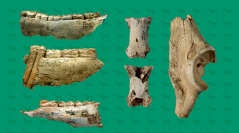

 Comptes Rendus Palevol
19 (11) - Pages 187-213
Comptes Rendus Palevol
19 (11) - Pages 187-213The study of ungulate assemblages is essential to understand hominins and carnivore behavior and interactions. For this reason, many studies involve the taphonomic analysis of faunal remains, focusing on the identification of the various biotic actors. This study looks at the horse assemblages from Mousterian and Aurignacian Units I, II and III from Bize-Tournal cave with the aim to characterizing the nature of this accumulation. Here we show that the horse remains in these units are mainly the consequence of carnivoran activity. Unit II also clearly evidences the fact that the assemblage is the result of hyena activity. Our analysis indicates a predominance of cranial remains and lower long limb bones (metapodials). The mortality profiles of the three units are different, although two are classic of a cursorial predator. Taphonomical and statistical analysis indicated that carnivores were the main modifying agent at the three units. Our results demonstrate that hominins played a minor role in horse accumulation. Additionally, it seems that there was little difference in the exploitation in this specie by Mousterian and Aurignacian groups, and this probably took place during short, sporadic hominin occupations.
Mousterian, Aurignacian, carnivorans, Taphotype, hyena, horse